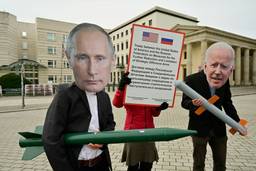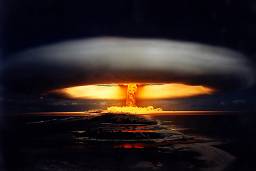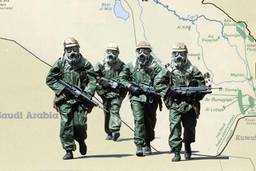Sixty-three years ago this week, the United States was the first (and last, so far) nation to use nuclear weapons in war, detonating two warheads in the cities of Hiroshima and Nagasaki, Japan. Tens of thousands were killed instantly by the explosions and by the end of 1945 more than 200,000 had died from radiation sickness and other bomb-related ailments.
This anniversary provides a somber moment to assess the current range of nuclear threats bedeviling international relations and threatening the future, and also to recommit to the work of nuclear disarmament.
The Good News
In a dramatic display, North Korea destroyed a cooling tower at their Yongbyon nuclear complex on June 28th. There is still significant work ahead, but this symbolic gesture is a welcome first step toward the country’s disarmament.
And, closer to home, Congress refused - for a second time - to fund the Bush administration’s demand for a new nuclear weapon system, the Reliable Replacement Warhead (RRW). The program - which would have replaced the core workings of all U.S. nuclear warheads over the next decade - was a lifeline for the nuclear weapons complex.
The Bad News
Stalled disarmament, irresponsible engagement with new and nascent nuclear powers, dangers of nuclear terrorism, ground gained by proponents of nuclear power, billions still being pumped into a nuclear weapons complex: These are just a few of the nuclear knots that still need to be unraveled. Let’s look briefly at each.
At the top of the list is the stalled disarmament between the two nuclear-armed Cold War rivals – the United States and Russia. In 2002, Presidents Bush and Putin agreed to sharp reductions in their nuclear stockpiles. But this key priority in the post-Cold War era has faltered and it is unlikely that either nation will meet the goals of cutting the number of active nuclear weapons by two-thirds.
While not living up to promised disarmament, the United States is being irresponsible and inconsistent throughout the world – supporting some states which possess nuclear weapons outside of international treaty obligations while punishing others. Washington’s stance toward India and Iran exemplify the two sides of this set of provocative policy choices.
The 1970 Nuclear Nonproliferation Treaty established the framework under which nuclear weapons states committed to disarm. Non-nuclear signers of the treaty pledged not to develop nuclear weapons in exchange for assistance in acquiring peaceful nuclear capabilities. But the treaty’s delicate balance has been overturned: Israel, North Korea, Pakistan and India have all built nuclear weapons stockpiles outside the treaty, while Iran is suspected of pursuing that technology.
Now, the Bush administration has further undermined this critical pillar of disarmament by giving India a special path to nuclear legitimacy despite its development of these weapons outside of international law. New Delhi is close to accepting a deal that gives it access to nuclear fuel and technology for power plants, in exchange for opening its nuclear weapons program to inspections. In early June, President Bush described the deal as “important… for our respective countries.”
While supporting India’s nuclear program, the United States threatens Iran with attack for thinking nuclear thoughts. According to the National Intelligence Estimate, Tehran ceased pursuit of nuclear weapons in 2003, while continuing to enrich uranium. Tehran maintains its current nuclear program is a lawful pursuit of peaceful energy resources, but the Bush administration continues to use the “all options are on the table” threat – code for “even nuclear weapons could be used in military strikes” – while pressing Iran for concessions.
Meanwhile John McCain – the man running for president on a record of foreign policy experience, military know-how and gravitas – sings “Bomb, Bomb Iran,” to the tune of The Beach Boys hit “Barbara Ann.” And the poison pens of armchair warriors are hard at work. Benny Morris, an Israeli historian writing in The New York Times, opined that “Israel’s own nuclear arsenal” could be “the only means available that will actually destroy the Iranian nuclear project,” laying out a new argument for the central fallacy of the Cold War – winnable nuclear war – long thought to be in the ash bin of history.
Nuclear Terrorism
Democratic presidential nominee Barack Obama has warned that nuclear terrorism is one of the gravest threats facing the United States today.
As a junior U.S. senator, he joined Republican Richard Lugar in championing the Cooperative Threat Reduction Program, which removes nuclear warheads from former-Soviet states and oversees the destruction and dismantlement of warheads and nuclear material. With a budget of about $1 billion a year, the program has succeeded in lessening the amount of raw materials available for nuclear terrorism.
Nuclear expert Graham Allison calls nuclear terrorism the “ultimate preventable catastrophe.” “(T)he increasing accessibility of weapons or nuclear materials from which elementary weapons could be constructed, and the countless ways by which terrorists could smuggle a weapon across America’s borders,” Allison has written, means that “if the U.S. and other governments keep doing what we are doing now, a nuclear terrorist attack is inevitable.”
But, he offers a formulation for prevention: we must seek a world with no loose nukes, no new nascent nukes and no new nuclear states.
There is a lot of work to do to reach those goals: large quantities of highly enriched uranium and plutonium remain scattered at poorly secured sites throughout the world. And the International Atomic Energy Agency warns that 20 to 30 countries have the intent or capability to pursue new nuclear weapons programs.
Bomb Factory Boom
Even as the threat of nuclear terrorism looms, nuclear power plants – relatively easy targets for terrorist attack – are making a comeback. The industry is taking advantage of $4-per-gallon gas and the burgeoning energy crisis to push Chernobyl/China Syndrome associations with nuclear power into the past. And it’s having an impact.
Republican nominee John McCain has called for 45 new nuclear reactors by 2030, asserting that they are “the cleanest, safest and most reliable energy source on earth.” His Democratic counterpart is also open to nuclear power, although he has made it clear that long-term storage, environmental impact and other issues will need to be satisfactorily dealt with before he is fully on board.
Neither candidate has addressed the major nuclear energy issue: cost. Each new U.S. nuclear reactor would cost about $2.5 billion. As Jim Riccio, a nuclear analyst with Greenpeace, points out, it is a “very expensive way to boil water.” He notes that every dollar spent to increase energy efficiencies and install renewable technologies is 7 to 10 times more efficient than a dollar invested in nuclear power.
New Nukes and ‘Complex Transformation’
In the midst of all these nuclear concerns and despite calls for nuclear disarmament from a cadre of converted Cold Warriors, the Bush administration continues to push for new nuclear weapons. Under his direction, the Department of Energy’s National Nuclear Security Administration (NNSA) is arguing for an estimated $150 billion in new spending aimed at developing a new generation of nuclear weapons and a more “responsive” production network.
The centerpiece of this move is called “Complex Transformation,” a multi-year plan to build new or upgraded facilities at each of the NNSA’s eight nuclear weapons-related sites. This proposal would build on the Bush administration’s quiet surge in nuclear weapons spending.
Adjusting for inflation, U.S. spending on nuclear weapons has increased by over 13 percent since 2001. More importantly, at this late date, the United States is still spending one-third more (again adjusted for inflation) than the Cold War average on nuclear weapons.
Five Minutes to Nuclear Midnight
The Bulletin of the Atomic Scientists has been measuring the danger posed by nuclear weapons since 1947. In January 2007, the group moved its Doomsday Clock from seven to five minutes to “nuclear midnight” partly due to “the perils of 27,000 nuclear weapons – 2,000 of them ready to launch within minutes…” The Bulletin only moves its clock due to changes in nuclear threats.
As we recall the terrible mushroom clouds incinerating Japanese cities 63 years ago this week, let us recommit ourselves to the work of nuclear disarmament before the Doomsday Clock is moved even one minute closer to nuclear midnight.
Frida Berrigan writes for TomDispatch, Waging Nonviolence and other outlets. Her book, It Runs in the Family: On Being Raised By Radicals and Growing Into Rebellious Motherhood, was published by OR Books in 2015. She lives in New London, Conn., with her husband, three kids and six chickens.








